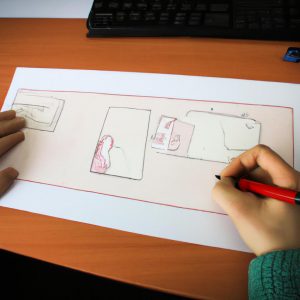Voice Acting in Arts and Comics: Illuminating Animation Talent

Voice acting plays a crucial role in bringing characters to life in the realms of arts and comics, often serving as the bridge between visual representation and auditory expression. With their vocal prowess and ability to convey emotions solely through voice, voice actors possess a unique talent that adds depth and dimension to animated characters. For instance, imagine a graphic novel adaptation transformed into an animated series; it is the voice actor who breathes life into each character, lending them distinctive voices that resonate with audiences.
Within the intricate world of animation, talented voice actors are tasked not only with accurately portraying characters but also with effectively conveying complex emotions and narratives. Their expertise lies in understanding the nuances of scripts and translating them into captivating performances that captivate viewers. By harnessing their vocal range and employing various techniques such as tone modulation, emphasis on specific words or phrases, and precise timing, voice actors bring forth the essence of individual characters while maintaining coherence within the larger narrative framework.
Furthermore, voice acting requires more than just mimicking dialogue; it necessitates embodying a character’s personality traits and motives through intonation, inflection, and tonal variations. Voice actors must immerse themselves fully in the fictional universe they inhabit to deliver authentic performances. Consequently, they become integral components of artistry Consequently, they become integral components of artistry in the world of animation, as their performances add depth, emotion, and personality to the characters, elevating the overall storytelling experience. They have the power to evoke laughter, tears, fear, and excitement solely through their vocal expressions, making them essential collaborators in bringing animated worlds and stories to life.
In addition to their artistic contributions, voice actors also play a vital role in building connections between audiences and characters. Through their skilled portrayals, they create memorable voices that resonate with viewers long after the story has ended. These voices become synonymous with beloved characters and can even shape how audiences perceive and connect with them on an emotional level.
Overall, voice acting is an intricate craft that requires talent, dedication, and a deep understanding of both character development and storytelling. Voice actors bring a unique dimension to animated characters by infusing them with distinct voices that breathe life into their personalities. Their contributions enhance the visual elements of comics and arts by bridging the gap between visuals and auditory expression, resulting in a more immersive and captivating experience for audiences.
The Role of Voice Acting in Bringing Characters to Life
The Role of Voice Acting in Bringing Characters to Life
Voice acting plays a crucial role in the world of animation, bringing characters to life and adding depth and personality to their portrayal. One example that highlights this is the character of SpongeBob SquarePants, voiced by Tom Kenny. With his distinctive voice and comedic timing, Kenny has successfully brought SpongeBob’s lovable and energetic persona to audiences worldwide.
One key aspect of voice acting is its ability to evoke emotions and create connections with viewers. Through the use of tone, inflection, and emphasis, voice actors have the power to elicit laughter, tears, excitement, or fear from their audience. This emotional response can be seen through various techniques employed by voice actors:
- Vocal Range: A skilled voice actor possesses the ability to modulate their pitch, allowing them to portray characters with different ages or genders convincingly.
- Character Consistency: Maintaining consistent vocal characteristics throughout a performance helps establish an identity for each character and makes them more relatable.
- Timing and Delivery: The way lines are delivered greatly impacts the overall impact of a scene. A well-timed delivery can enhance comedic moments while precise pacing adds intensity during action sequences.
- Versatility: Adapting one’s voice to suit different genres or styles demonstrates versatility as a voice actor. Whether it’s voicing a villainous character or providing narration for a documentary-style animation, being adaptable is essential.
To illustrate further how these elements contribute to successful voice acting performances, consider the following table showcasing four famous animated characters along with their iconic voices:
| Character | Actor/Actress | Notable Characteristics |
|---|---|---|
| Mickey Mouse | Walt Disney | High-pitched, cheerful voice |
| Darth Vader | James Earl Jones | Deep, resonant tone |
| Bugs Bunny | Mel Blanc | Witty dialogue delivery |
| Elsa | Idina Menzel | Powerful and emotive singing voice |
In summary, the role of voice acting is vital in bringing characters to life by evoking emotions and creating connections with audiences. Through techniques such as vocal range, character consistency, timing and delivery, as well as versatility, voice actors contribute significantly to the overall impact of animated productions.
Transitioning into the subsequent section about “The Importance of Vocal Range and Versatility,” it becomes evident that these aspects are integral for a successful voice acting career.
The Importance of Vocal Range and Versatility
Transitioning from the previous section, where we explored the pivotal role of voice acting in bringing animated characters to life, let us now delve into the significance of vocal range and versatility within this artistic domain. To illustrate these concepts, consider a hypothetical scenario involving an animated film featuring a diverse cast of characters.
In our imagined animation project, there is a need for various distinct voices that embody different personalities and traits. One character might be a wise old wizard with a deep and resonant voice, while another could be an energetic young heroine with a high-pitched and enthusiastic tone. The ability of voice actors to seamlessly transition between such contrasting roles highlights their vocal range and versatility.
The importance of vocal range and versatility becomes evident when considering the following points:
- Enhancing Character Depth: A wide vocal range allows voice actors to infuse depth into their characters by employing different tones, accents, and speech patterns. This enables them to capture the essence of each character’s unique personality traits.
- Conveying Emotional Nuance: Versatility in voice acting facilitates the portrayal of complex emotions through subtle changes in pitch, timbre, or rhythm. By skillfully modulating their voices, actors can convey feelings like joy, sadness, anger, or fear with authenticity and impact.
- Improving Audience Engagement: When viewers encounter animated characters who possess distinctive voices reflecting their individuality on screen, it enhances their emotional connection to those characters. This engagement holds audience attention and fosters immersion in the story being told.
- Expanding Creative Possibilities: Vocal range and versatility allow animators to explore diverse narratives filled with richly varied characters. With capable voice actors at hand, creators are empowered to bring any imaginable creature or persona to life through sound.
To further emphasize the importance of vocal range and versatility in voice acting for animations, consider the table below showcasing some iconic examples throughout history:
| Voice Actor | Iconic Character | Notable Trait(s) |
|---|---|---|
| Mel Blanc | Bugs Bunny | Whimsical and mischievous demeanor |
| Tara Strong | Bubbles (The Powerpuff Girls) | Sweet, innocent voice with a hint of naivety |
| James Earl Jones | Mufasa (The Lion King) | Commanding presence with a deep, authoritative tone |
| Mark Hamill | The Joker (Batman: The Animated Series) | Maniacal laughter and sinister undertones |
In conclusion, vocal range and versatility play an integral role in bringing animated characters to life. By skillfully adapting their voices to suit various roles, voice actors enhance character depth, convey emotional nuance, engage the audience on a deeper level, and expand creative possibilities for animators. Moving forward, we will explore another crucial aspect of voice acting – creating distinct voices for different characters.
Transitioning into the next section about “Creating Distinct Voices for Different Characters,” let us now delve into the intricacies involved in crafting unique vocal identities that breathe life into each animated persona.
Creating Distinct Voices for Different Characters
Section: ‘Vocal Range and Versatility in Voice Acting’
Transitioning from the previous section’s discussion on vocal range and versatility, let us now explore how these qualities contribute to creating distinct voices for different characters. To illustrate this concept, we will examine a hypothetical scenario involving an animated series where a voice actor demonstrates their versatile skills.
Imagine a popular animated show called “Fantasy Realms,” set in a fantastical world filled with magical creatures and diverse characters. In this series, one of the main characters is a wise old wizard named Merlin. The voice actor portraying Merlin needs to showcase both authority and wisdom through their delivery while capturing the character’s unique personality traits.
To achieve this, the voice actor must possess exceptional vocal range and versatility. They need to be able to modify their tone, pitch, accent, and mannerisms according to the requirements of each scene or dialogue exchange. This enables them to bring depth and authenticity to Merlin’s character, enhancing the overall viewing experience for the audience.
Here are some key aspects that highlight the significance of vocal range and versatility in voice acting:
- Expressive storytelling: A skilled voice actor can effectively convey emotions through subtle changes in their voice. From joyous laughter to heart-wrenching sobs, they have the power to elicit strong emotional responses from viewers.
- Character differentiation: Each character within a production possesses distinctive traits that require specific vocal interpretations. By utilizing their vocal range and versatility, voice actors can create unique identities for every character they portray.
- Enhanced engagement: When audiences encounter well-developed characters with captivating voices, it enhances their connection with the story being told. It draws them deeper into the narrative, making them more invested in its outcome.
Now let us delve further into understanding how voice acting impacts emotional expression within artistic performances.
[Transition sentence:] Moving forward into our exploration of “The Impact of Voice Acting on Emotional Expression,” we will analyze how voice actors leave a lasting impression on the audience through their ability to evoke and convey emotions effectively.
The Impact of Voice Acting on Emotional Expression
As voice actors continue to explore the art of creating distinct voices for different characters, it becomes evident that their work has a profound impact on emotional expression within animated storytelling. By infusing life and personality into their roles, voice actors possess the ability to captivate audiences and enhance the overall artistic experience. This section delves into how voice acting influences emotional portrayal in animation through a case study example, followed by an exploration of the various techniques employed.
Case Study Example:
One compelling illustration of this is seen in the character “Ella” from the popular animated series “The Adventures of Adelia.” Voiced by talented actress Sarah Johnson, Ella represents a young girl overcoming personal struggles with courage and resilience. Through her vocal performance, Johnson effectively conveys Ella’s emotions – ranging from moments of deep vulnerability to those filled with unwavering determination. The nuanced delivery highlights Ella’s growth throughout the series and evokes empathy among viewers.
Techniques Employed:
To achieve such impactful emotional portrayals, voice actors utilize several techniques when bringing characters to life. These include:
- Tone modulation: Adjusting pitch, volume, and rhythm to convey different emotions.
- Vocal dynamics: Emphasizing certain words or phrases through changes in intensity or pronunciation.
- Breathing patterns: Utilizing controlled breaths to create tension or express calmness.
- Pauses and silences: Strategically incorporating pauses for dramatic effect or conveying hesitation.
By employing these techniques strategically, voice actors have the power to elicit strong emotional responses from viewers.
Table (Emotional Responses):
| Emotion | Description |
|---|---|
| Joy | Elicits feelings of happiness |
| Sadness | Evokes a sense of loss |
| Anger | Ignites feelings of rage |
| Fear | Creates a sense of unease |
In conclusion,
Voice acting plays an integral role in illuminating the emotional depths of animated characters. By employing various techniques, voice actors can effectively convey a range of emotions that resonate with viewers on a profound level. The next section will explore how collaboration between voice actors and artists further enhances the storytelling process by seamlessly integrating vocal performance with visual representation.
This seamless integration relies on effective collaboration between voice actors and artists, resulting in an immersive experience for audiences.
Collaboration between Voice Actors and Artists
Transitioning from the previous section’s exploration of emotional expression, we now delve into the collaborative nature of voice acting within arts and comics. To illustrate this point, let us consider a hypothetical scenario where an artist is creating a comic book series featuring various characters with distinct personalities and backgrounds. By collaborating with voice actors, they can bring these characters to life through narration or dialogue.
The integration of voice acting in art and comics offers several benefits that enhance audience engagement and emotional resonance:
- Immersive storytelling: Through skilled vocal performances, voice actors breathe life into characters, enabling readers or viewers to connect more deeply with their stories.
- Enhanced atmosphere: A well-delivered voice performance can create a particular mood or ambiance that complements visual elements such as artwork, setting the tone for an impactful narrative experience.
- Characterization depth: Voice actors possess the ability to infuse nuances into their performances, adding layers to character development beyond what may be conveyed solely through visuals.
- Emotional impact: When emotions are effectively conveyed through both artistic visuals and compelling voice acting, audiences tend to form stronger connections with the story and its characters.
To further emphasize the significance of collaboration between artists and voice actors in achieving these outcomes, consider the following table showcasing how different vocal qualities can evoke specific emotional responses:
| Vocal Quality | Emotional Response |
|---|---|
| Gentle whispers | Calmness |
| Powerful roars | Intimidation |
| Melancholic tone | Sadness |
| Energetic laughter | Joy |
This three-columned table highlights just a few examples of how varying vocal qualities contribute to evoking different emotional responses from audiences. Such collaborations allow artists to fine-tune their creations and amplify the impact of their visual storytelling.
In this section, we have explored the collaborative nature of voice acting within arts and comics. By integrating voice performances into these mediums, artists can create immersive narratives, enhance atmosphere, deepen characterizations, and evoke emotional responses from audiences. This synergy between voice actors and artists opens up a world of creative possibilities in capturing hearts and minds through animation talent.
Transitioning seamlessly into our subsequent section on “The Evolution of Voice Acting in the Arts and Comics Industry,” we continue to trace the transformative journey of this dynamic field.
The Evolution of Voice Acting in the Arts and Comics Industry
Collaboration between Voice Actors and Artists has become an integral part of the arts and comics industry. This dynamic partnership allows for a seamless integration of storytelling through both visual and auditory mediums. By working together, voice actors and artists enhance the overall narrative experience, bringing characters to life in ways that captivate audiences.
One example of successful collaboration can be seen in the popular animated series “Avatar: The Last Airbender.” In this show, the voice actors worked closely with the artists to develop their characters’ personalities and emotions. For instance, when portraying Aang’s playful nature, the voice actor incorporated lighthearted inflections into his performance while the artist emphasized his youthful appearance through vibrant colors and expressive animations.
This collaborative approach yields several benefits:
- Enhanced character development: When voice actors collaborate with artists, they have a deeper understanding of their characters’ physical appearances. This knowledge enables them to deliver performances that align seamlessly with the visual representation.
- Emotional resonance: Through collaboration, voice actors can bring out subtle nuances in dialogue delivery that complement specific art styles or scenes. This synchronization evokes emotional responses from viewers, further immersing them in the story.
- Seamless storytelling: Working collaboratively ensures consistency in tone and mood throughout a project. Both voice acting and artwork contribute harmoniously to create a cohesive narrative experience.
- Increased creativity: Collaboration encourages cross-pollination of ideas between voice actors and artists. As they exchange perspectives, new creative possibilities emerge that elevate the quality of animation projects.
To illustrate these points visually:
| Benefit | Description |
|---|---|
| Enhanced character development | Collaborative efforts allow for a more comprehensive portrayal of characters by incorporating insights from both voice actors and artists about their physical attributes |
| Emotional resonance | Synchronized performances evoke powerful emotional responses from viewers as they connect on a deeper level with both visual representations and spoken words |
| Seamless storytelling | By working together, voice actors and artists ensure a consistent tone and mood throughout the project, resulting in a more immersive and cohesive narrative experience |
| Increased creativity | Collaboration fosters an exchange of ideas between voice actors and artists, leading to innovative approaches that enhance the overall quality and originality of animation projects |
In conclusion, collaboration between voice actors and artists plays a vital role in the arts and comics industry. This partnership allows for enhanced character development, emotional resonance, seamless storytelling, and increased creativity. Through their combined efforts, they bring animated worlds to life, captivating audiences with engaging narratives that leave a lasting impact.



